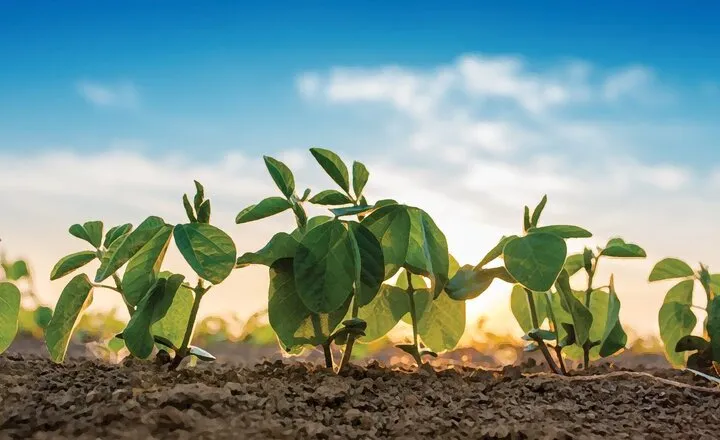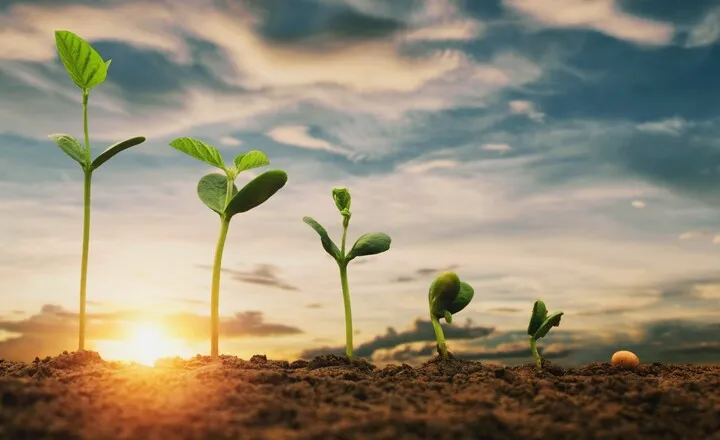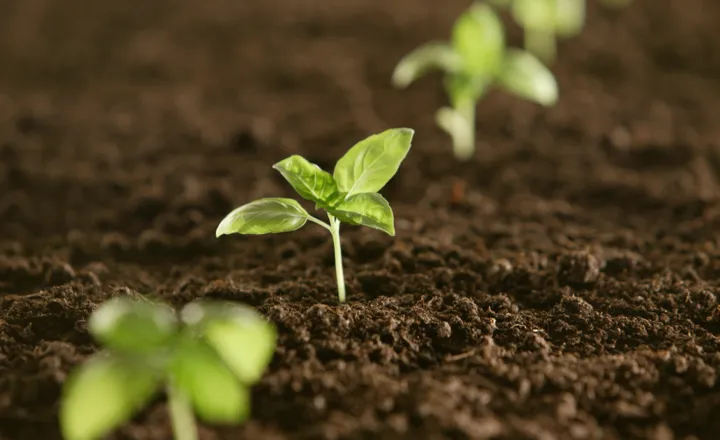Planting soybeans is more than just dropping seeds into the ground; it’s an intricate dance of timing and environmental factors. Optimal planting time typically falls between late April and early June, depending on your region’s climate.
Savvy growers know that soil temperature plays a critical role in sprouting success. Aim for at least 68 to 77°F before you plant. This ensures not only quick germination but also robust root development, setting the stage for exceptional yields.
Soybeans Generally
Soybeans are fascinating plants with a unique growth structure and symbiotic relationships that contribute to their agricultural success. As a one-year-old plant, soybeans are primarily cultivated for their seeds, which are rich in protein and oil, making them a staple in both human and animal diets.
The robust root system of the soybean not only supports the plant structurally but also plays a crucial role in nutrient absorption.
The presence of nodules containing the bacterium Bradyrhizobium japonicum is particularly significant; this relationship allows soybeans to fix atmospheric nitrogen, enriching the soil and reducing the need for synthetic fertilizers.
In terms of physical characteristics, commercial soybean varieties typically feature an upright stem ranging from 30 to 47 inches tall, with leaves that can vary in color from light to dark green.
The small hairs on the stems and pods help protect the plant from pests while contributing to its overall resilience. This combination of structural integrity and beneficial microbial associations makes soybeans an essential crop in sustainable agriculture, promoting soil health while meeting global food demands.
Morphological properties of soybeans
Soybeans exhibit a range of morphological properties that are crucial for their growth and development. The root system is particularly noteworthy, consisting of strong main and lateral spindle roots that provide a high absorption capacity for water and nutrients.
A unique feature of soybean roots is the formation of nodules containing the symbiotic bacteria Bradyrhizobium japonicum. These bacteria play a vital role in nitrogen fixation, allowing soybeans to thrive in various soil conditions by converting atmospheric nitrogen into a form usable by the plant.
They typically have upright and sturdy stems, with heights ranging from 30 to 47 inches depending on genetic factors and growing conditions. The leaves are another important aspect; they vary in color from pale green to dark green and can number between 15 to 20 per plant.
As the plant matures, these leaves turn yellow before falling off. The flowers, which can be white, purple, or mixed colors, grow in clusters and eventually give way to legumes that contain seeds varying in color from light straw yellow to nearly black upon maturity.
This complex morphology not only contributes to the plant’s adaptability but also enhances its agricultural value as a key crop worldwide.
Soybean planting and growing
Soybeans thrive in rich, well-drained soils with a neutral pH, ideally around 7. Prior to planting soybeans, it’s essential to prepare the soil through basic tillage, which involves plowing to a depth of 10 to 12 inches.
The choice of pre-crops can significantly impact soybean yield; sugar beet and corn are excellent options, while sunflower and rapeseed should be avoided.
After harvesting these pre-crops, it’s crucial to allow a break of two to four years before replanting soybeans on the same land to prevent disease buildup and ensure soil fertility.

When it comes time for sowing between May and early July when soil temperatures are optimal and frost risk has passed, seeds should be planted at a depth of one inch with spacing of about four inches apart in rows that are 20 inches apart.
For those in cooler climates, starting seeds indoors in pots or trays filled with compost is advisable. This allows for better control over growing conditions until they are robust enough for transplantation outdoors.
Proper seed selection—ensuring they are untreated and undamaged—is vital for successful germination and growth. By following these guidelines, you can set the stage for a productive soybean crop.
Maintenance of soybean plantation
Maintaining a soybean plantation requires careful attention to temperature, nutrient needs, and watering practices. Given that soybeans are not frost-resistant, it’s crucial to ensure they are planted in an environment where temperatures remain within the optimal range of 68 to 77°F.
After germination, thinning the plants is essential to promote healthy growth; leaving the strongest plants ensures better yield potential. As soybeans progress from flowering to pod formation, their nutrient demands increase significantly, necessitating adequate supplies of nitrogen, potassium, sulfur, and phosphorus.
Water management plays a vital role in soybean cultivation. Regular watering is particularly important during the first year and during dry spells to maintain soil moisture levels.
While soybeans can tolerate some drought between sprouting and flowering phases without severely impacting yield, consistent moisture is key for robust plant development. Cultivation practices should also be implemented at appropriate growth stages
Initially between rows after sprouting and again when plants reach about 12 inches—to support healthy root systems and reduce competition from weeds.
Disease protection
To protect soybeans from diseases like leaf spot, white mold, and blight, implementing an integrated disease management strategy is essential. Crop rotation is a fundamental practice that can help break the life cycles of these pathogens.
By rotating soybeans with non-host crops, farmers can reduce the buildup of disease in the soil. Selecting disease-resistant soybean varieties can significantly mitigate the impact of these diseases. Researching and choosing cultivars that are bred for resistance to specific pathogens can lead to healthier plants and better yields.
Proper field management practices also play a crucial role in disease prevention. Ensuring adequate spacing between plants improves air circulation, which helps reduce humidity levels around the foliage—conditions that favor disease development.
Regular monitoring for early signs of infection allows for timely intervention, whether through fungicide applications or cultural practices like removing infected plant debris.
Soybean harvest
Harvesting soybeans efficiently requires careful adjustments to the harvester to minimize losses and maximize yield. The ideal moisture content for harvesting is between 14% and 16%. If the moisture level exceeds 20%, it’s essential to reduce the harvester’s capacity to prevent damage to the crop.
Maintaining an appropriate speed is crucial; operating at no more than 3 mph (or about 5 km/h) helps ensure that the plants are cut cleanly without causing the beans to shatter or fall off prematurely.

Their yields can range from 2.5 to 3.5 tonnes per hectare, with potential increases beyond 4 tonnes per hectare on fertile soils using proper techniques. To achieve these yields, farmers should focus not only on adjusting their equipment but also on timing their harvest correctly based on moisture levels and plant maturity.
Soybean storage
It’s crucial to manage both temperature and humidity effectively to preserve seed quality. They should be stored in a cool, dry environment where the relative humidity is kept low.
This helps prevent moisture absorption, which can lead to mold growth and spoilage. Regular monitoring of storage conditions is essential; using hygrometers and thermometers can help maintain optimal levels and alert you to any fluctuations that could jeopardize the integrity of the seeds.
Proper ventilation is key in plant storage. Ensuring adequate airflow can help dissipate heat and moisture that may accumulate within the storage facility.
It’s also advisable to keep soybeans away from chemicals or substances that could cause chemical changes in the grain, as these can negatively impact seed viability and overall quality.
Soybeans in the kitchen
They are incredibly versatile in the kitchen, offering a variety of culinary applications beyond just salads. When using soybean sprouts or green seeds, it’s essential to wash and peel them thoroughly to ensure a clean taste and texture.
Cooking them briefly in boiling water not only enhances their flavor but also makes them more digestible. After cooking for around 15 minutes, they can be enjoyed as a nutritious side dish or incorporated into main courses, adding protein and fiber to your meals.
They play a significant role in many processed foods. Their oil is commonly used in cooking and baking, while soy milk serves as an excellent dairy alternative for those who are lactose intolerant or following a vegan diet.
Tofu, made through fermentation of crushed soybeans, is another popular ingredient that mimics cheese’s texture and is rich in protein—making it a staple for vegetarian and vegan diets alike.
Medicinal properties of soybeans
They offer numerous medicinal properties that contribute to overall health. Rich in protein and fiber, they serve as an excellent plant-based source of essential nutrients, making them particularly beneficial for vegetarians and vegans.
The high potassium and iron content supports cardiovascular health and helps maintain energy levels. Vitamins E and B found in soybeans play crucial roles in skin health and metabolism.
Beyond their nutritional benefits, soybeans have been linked to several health advantages. They can aid in digestive issues due to their fiber content and help lower harmful cholesterol levels, which is vital for heart health.
Studies suggest that the phytoestrogens present in soy can alleviate menopausal symptoms such as hot flashes and mood swings, providing a natural alternative for women experiencing these changes.
History of soybeans
The history of soybeans is a fascinating journey that highlights their significance in agriculture and cuisine across cultures. Native to Asia, soybeans have been cultivated for thousands of years, with evidence suggesting their domestication dates back to around 1100 BC in China during the reign of Emperor Shen Nung.
Initially valued for their nitrogen-fixing properties that improved soil fertility, soybeans soon became an essential food source, particularly in East Asian diets where they are used to make products like tofu and soy sauce.
By the 17th century, soybeans made their way to Europe through Dutch physician Engleberg Kaempfer, who recognized their potential while living in Japan. In the 19th century, they were considered a luxury item in the UK.

Soybeans are celebrated globally not only as a nutritious food rich in protein but also for their versatility in various industries. They play a crucial role in animal feed and are integral to numerous industrial applications due to components like lecithin found in soybean oil.
Conclusion
Soybeans offer a remarkable array of medicinal properties that can significantly enhance overall health and well-being. Their high protein and fiber content, coupled with essential vitamins and minerals, make them an excellent addition to any diet.
The benefits of soy extend beyond basic nutrition, as they can effectively address various health concerns such as menopausal symptoms and cholesterol management. With their versatility in cooking and low-calorie nature, incorporating soy into meals is both easy and beneficial for maintaining a healthy lifestyle.
FAQs
Do soybeans need sunlight?
Yes, soybeans do need sunlight to grow effectively. Like most plants, soybeans rely on photosynthesis to convert light energy into chemical energy, which fuels their growth and development.
What is R2 in soybeans?
R2 in soybeans refers to a specific growth stage in the soybean plant’s development, known as the full flower stage.
